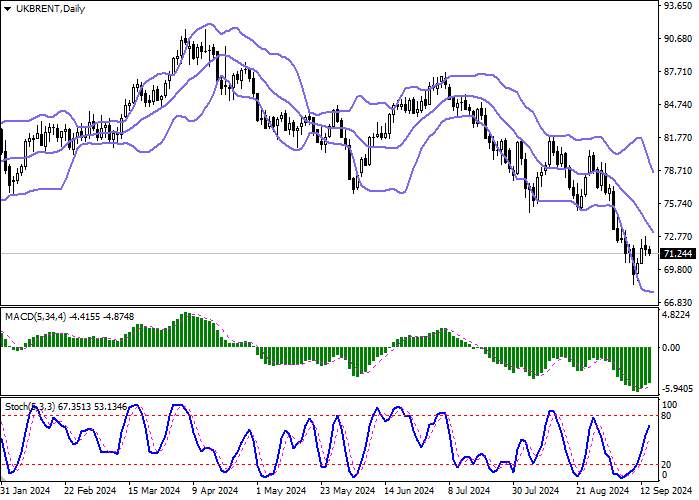Current trend
At the beginning of the week, Brent Crude Oil prices are developing a poor “bearish” momentum formed on Friday, when the quotes retreated from the highs of September 6, and are testing 71.20 for a breakdown. Traders are awaiting the results of the two-day meeting of the US Fed, which will begin tomorrow. Experts expect an adjustment of the interest rate by –25 basis points to 5.00% and signals about further actions of the department.
In turn, Hurricane Francine, which disrupted the operation of several platforms in the Gulf of Mexico, acted as a driver of price growth. On Thursday, about 42.0% of capacity in the region was stopped, which could lead to a drop in total US production by 50.0–60.0K barrels per day.
On the other hand, the asset is under pressure from the decisions of OPEC and the International Energy Agency (IEA), reducing preliminary estimates of oil demand against a slowdown in the European and Chinese economies. Over the weekend, Chinese macroeconomic statistics supported these concerns. The August industrial production volumes fell from 5.1% to 4.5%, below estimates of 4.8%, and retail sales – from 2.7% to 2.1% compared to 2.5%. Meanwhile, analysts report a slower-than-expected growth in oil demand, believing that one of the main reasons is China’s transition to more environmentally friendly fuels and a decrease in demand for gasoline in other developed countries. Thus, Brent Crude Oil futures fell from a high of 82.0 dollars per barrel in early August to an almost three-year low below 70.0 dollars per barrel, despite a decrease in Libyan oil supplies and an ongoing reduction in reserves. The indicator may increase by only 900.0K barrels per day in 2024 and by 950K barrels per day next year. It leads to consumption in advanced economies being almost 2.0K barrels per day below the level before the COVID–19 epidemic.
Support and resistance
On the daily chart, Bollinger Bands are steadily declining. The price range is actively narrowing, reflecting the emergence of ambiguous trading dynamics in the short term. The MACD indicator is reversed upwards, forming a buy signal (the histogram is above the signal line). Stochastic is approaching the highs, indicating that the trading instrument may become overbought in the ultra-short term.
Resistance levels: 72.00, 73.00, 74.00, 75.04.
Support levels: 71.00, 70.00, 69.00, 68.00.


Trading tips
Short positions may be opened after a breakdown of 71.00, with the target at 69.00. Stop loss — 72.00. Implementation period: 1–2 days.
Long positions may be opened after a rebound from the 71.00 level and a breakout of 72.00, with the target at 74.00. Stop loss — 71.00.





Hot
No comment on record. Start new comment.